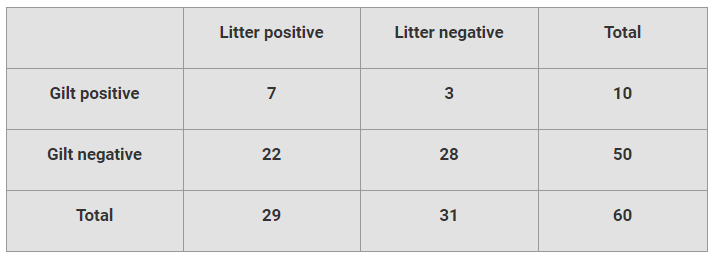



Comparing PCV2 gilt vaccination protocols and progeny status
Porcine circovirus type 2 (PCV2) is the principal etiological agent of porcine circovirus associated disease (PCVAD), which can cost producers an estimated $3 to $4 per pig.“Because vertical transmission is a common pathway to exposing pigs to PCV2, stabilizing the sow herd has become a positive management practice,” Kate Mathes, veterinary student at Iowa State University, told Pig Health Today.
Mathes set up a study1 with the following objectives:
- Evaluate the association of pregnant gilts’ PCV2 status with their progeny’s PCV2 status.
- Determine if an additional PCV2 vaccination for the gilts would impact the progeny’s PCV2 status.
Materials and methods
For the study, gilts from two sources were randomly selected from the first two deliveries to a brand-new sow farm. A total of 100 gilts, 25 to 28 weeks of age, were divided equally between the two sources.
All of the gilts received two full doses of a PCV2 vaccine prior to reaching the sow farm, with a third dose administered upon arrival. Blood samples were collected from each gilt upon arrival and again at pregnancy confirmation. The gilts were then randomly allocated to one of two treatment groups:
- Group 1 (n = 50) was re-vaccinated with a full dose of a PCV2 vaccine (for a total of four vaccinations).
- Group 2 (n = 50) did not receive an additional vaccine.
After farrowing, piglet processing fluids were collected from each litter, and three piglets - small, medium and large - were selected from each litter and ear-tagged. Blood samples were collected from those pigs at weaning.
Serum samples for gilts were tested individually at pregnancy confirmation, whereas piglet samples were pooled by litter for polymerase chain reaction (PCR) PCV2 testing. Processing fluids also were analyzed by litter with PCR.
“As the study progressed, 40 gilts were removed for various reasons unrelated to treatment - 28 in Group 1 and 32 in Group 2,” Mathes said. “For those animals, neither the gilt nor the associated litter data were used.”
She also noted that cross-fostering was not allowed for the participating litters. A cycle threshold value greater than or equal to 37 was considered negative for PCV2.
The outcome
Upon arriving at the sow farm, 69 percent of gilts from source A and 88 percent from source B tested PCR-positive for PCV2. The study showed that vaccination protocol - Group 1 versus Group 2 - had no significant effect on PCV2 status for processing fluids or weaned-pig serum. Also, there was no statistical association between the gilts’ PCV2 status at pregnancy confirmation and the individual litter’s status at processing. (See the accompanying table.)
“The additional PCV2 vaccination administered to pregnant gilts at 42 days of gestation in this study had no impact on the gilts’ or piglets’ PCV2 status,” Mathes said. “Future studies should consider gilt status prior to breeding and the role of environmental contamination in processing-fluid collection.”

| References | ||||
|---|---|---|---|---|
| 1 Mathes K, et al. | ||||
| (2020) | Porcine circovirus type 2 (PCV2) stabilization of replacement gilts by vaccination and the impact on offspring PCV2 status.. Student Research Posters. Am Assoc. Swine Vet Annual Meeting. | 2020;261. |








